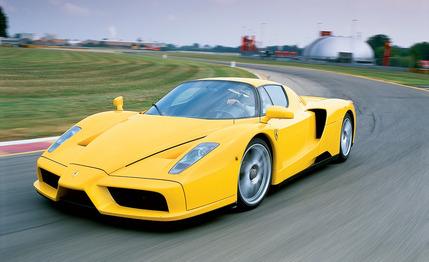
 First Drive Review
First Drive Review
Dario Benuzzi, Ferrari's famous rubber-burning test driver, wants to demonstrate the new Enzo's brakes, not its acceleration. He understands that to show off its stopping power the supercar will also reveal its massive performance.
At Ferrari's test track, Benuzzi stretches the new 6.0-liter V-12 to the 8200-rpm rev limiter — exhaust howling — in first, second, third, then fourth gear, and we flash through the left-hand chink at 150 mph (6800 rpm in fifth). Benuzzi is grinning, knowing what comes next. He hits the brakes, left hand simultaneously tapping the paddle to downshift, revs automatically soaring between each 0.15-second shift. The brakes growl, the 19-inch Bridgestone Scuderia rubber scrambles for grip. The Enzo stays straight, flat. Under the staggering deceleration, our eyes water and our bodies strain against the four-point belts. It's as if some secondary magnetic force were slowing the Ferrari, dragging it into the track surface. Three-lap demonstration over, motion sickness induced, Benuzzi tells us the discs are 25,000 miles old and have been through a series of 200-to-0-mph tests.
These are no ordinary brakes; they're Brembo's new 14.9-inch Carbon-Ceramic Material system, which boasts a significant 27.5-pound weight saving and consistent stopping regardless.
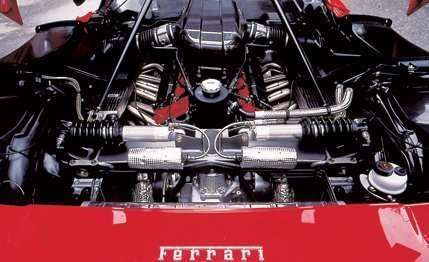

The bare facts for Ferrari's Enzo are: 650 horsepower, 3000 pounds, a top speed of 218 mph, 11.0 seconds for the standing quarter-mile, a price of about $650,000, and 349 of them to be built — numbers that make this the fastest, most expensive Ferrari of all time.
Officially, the supercar is the Ferrari Enzo Ferrari, but Maranello realistically acknowledges it as just the "Enzo." In virtually every area, this spiritual successor to the 288GTO, F40, and F50 steps outside Ferrari's existing order. The Enzo pushes road-car technology barriers and incorporates enough Formula 1 philosophy to go far beyond merely celebrating Ferrari's three (going on four) consecutive world-championship titles. Ferrari president Luca di Montezemolo says, "I wanted to go a little bit too far in every element to build a superextreme car."
The Pininfarina-styled Enzo looks intense, purposeful, dramatic, mean, and smaller than the F50. The front end mirrors the F1 car with its raised nose splitting the two side vents, and it's at odds with the softer, curvaceous tail. It's an aerodynamic statement, and what you don't see is an underbody tailored to wind-tunnel demands. Flaps ahead of the front wheels work in unison with the small, adjustable rear spoiler and two rear diffusers to give a downforce load of 756 pounds at 124 mph, increasing to 1709 pounds at 186 mph before it gradually decreases to 1290 pounds at top speed.
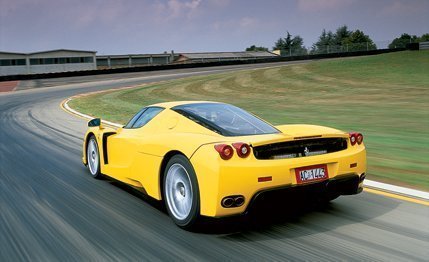

The doors include a section of roof and the lower sill, and they're hinged at the roof and waistline to open up and forward. You step in feet first and slide down into the racing bucket. The cockpit offers a comfortable driving position, even for tall drivers. There's air conditioning, but no sound system. Apart from a few patches of leather, the interior is carbon fiber (the composite chassis and body use sandwich panels of it and aluminum honeycomb).
In imitation of Ferrari F1 driver Schumacher's Sunday car, many controls (including those for reverse gear and traction control) are located on the steering wheel along with warning lights that flash in 500-rpm segments beyond 5500 rpm.
You shift gears F1-style, without a clutch pedal, via column-mounted paddles just behind the steering wheel. Unlike the 360/575M, there's no auto mode. The Enzo slides smoothly away, no awkward clutch takeup. We're in learning mode, short-shifting to second and third, conscious of the engine's remarkable flexibility. The power steering is quick (just 2.2 turns) and fluid; the car feels agile, easy to drive, and far from intimidating. The brakes rumble at every stop; we know how powerful they are.
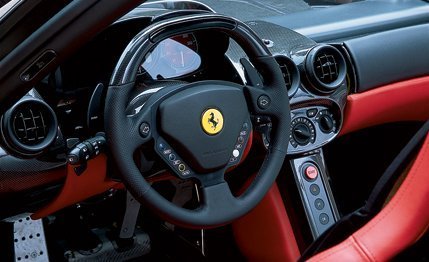

The Enzo delivers sound on demand. At light throttle the engine is a distant rumble. Push it, and the computer knows by throttle position, revs, and speed when to open the exhaust bypass valves, kicking off a deep, smooth goose-bump-inducing howl. You take the rush for granted, the Enzo passing from leisurely to 150 mph seemingly without going through an intermediate stage.
Ferrari now acknowledges that the F50's F1-based V-12 left drivers yearning for more torque. For this car, a new naturally aspirated, 65-degree V-12 was developed, and it will go in the successors to the 456 and 575M. The Enzo V-12's 92mm bore and 75.2mm stroke give a capacity of 5999cc. The quad cams are belt-driven with variable inlet- and exhaust-valve timing, and the intake-runner lengths are continuously variable. Each bank of cylinders is controlled by a Bosch Motronic ME7.0 ECU and fed via a drive-by-wire throttle, with a single coil for each spark plug. The V-12 makes 650 horsepower at 7800 rpm and 485 pound-feet of torque at 5500 rpm. At 3000 rpm, it's still punching out 391 pound-feet of torque, whereas the F50 peaked at 347 pound-feet at 6500 rpm.
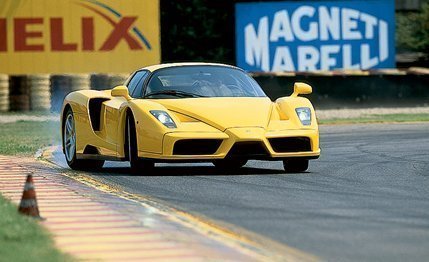

To keep control on public roads, world champ Schumacher insisted Ferrari lower the threshold of the ASR (traction control) intervention in its default mode. Race mode raises that level for aggressive driving; switch off the ASR for track work. In tight corners, the Enzo understeers moderately. Above 80 mph you increasingly feel the downforce working, the handling balance changing to whatever the driver's right foot demands in ASR's off or race mode. The pushrod-actuated control-arm front and rear suspension works with continuously variable dampers to maximize body control and comfort as required.
The Enzo — it comes only in red and yellow — requires a massive upward adjustment of expectations. No surprise that even at the greatly elevated price all 349 Enzos are spoken for.